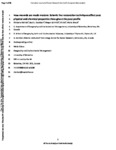How mounds are made matters: Seismic line restoration techniques affect peat physical and chemical properties throughout the peat profile
| dc.contributor.author | Kleinke, K | |
| dc.contributor.author | Davidson, Scott J. | |
| dc.contributor.author | Schmidt, M | |
| dc.contributor.author | Xu, B | |
| dc.contributor.author | Strack, M | |
| dc.date.accessioned | 2022-06-12T11:30:33Z | |
| dc.date.available | 2022-06-12T11:30:33Z | |
| dc.date.issued | 2022-05-03 | |
| dc.identifier.issn | 0045-5067 | |
| dc.identifier.issn | 1208-6037 | |
| dc.identifier.uri | http://hdl.handle.net/10026.1/19291 | |
| dc.description.abstract |
<jats:p> Seismic lines are prominent linear disturbances across boreal Canada with large-scale consequences to wildlife and ecosystem function. Although seismic line restoration has been observed to improve tree growth and survival, application in peatlands has been shown to alter ecosystem functions such as hydrology and carbon storage. The most common active restoration method is called mechanical mounding where the classic technique inverts the peat profile. New mounding methods that maintain the peat profile may provide benefits by preserving existing vegetation and reducing disturbance. To determine the effects of different mounding methods on soil quality, peat cores were collected and analyzed from two different sites for various soil properties (C/N ratios, δ13C, δ15N, Fourier transform infrared (FTIR) spectroscopy humification indices). Vegetation surveys were also conducted. The two sites are both a collection of seismic lines crossing poor fens in Alberta. One site was treated with the classic method while the other was treated with two new mounding methods. Classic mechanical mounding significantly increased the degree of decomposition, indicative of lower substrate quality. Mechanical mounding also greatly reduced moss cover and introduced large amounts of bare ground cover. The two newer mounding methods did not result in these changes and were largely comparable to natural peat properties and vegetation communities. Preserving the peat profile in new mounding methods may support faster return of ecosystem function. </jats:p> | |
| dc.format.extent | 963-976 | |
| dc.language | en | |
| dc.language.iso | en | |
| dc.publisher | Canadian Science Publishing | |
| dc.subject | organic soil | |
| dc.subject | bulk density | |
| dc.subject | mechanical mounding | |
| dc.subject | C | |
| dc.subject | N ratio | |
| dc.subject | stable isotopes | |
| dc.title | How mounds are made matters: Seismic line restoration techniques affect peat physical and chemical properties throughout the peat profile | |
| dc.type | journal-article | |
| dc.type | Journal Article | |
| plymouth.author-url | https://www.webofscience.com/api/gateway?GWVersion=2&SrcApp=PARTNER_APP&SrcAuth=LinksAMR&KeyUT=WOS:000830542600001&DestLinkType=FullRecord&DestApp=ALL_WOS&UsrCustomerID=11bb513d99f797142bcfeffcc58ea008 | |
| plymouth.issue | 6 | |
| plymouth.volume | 52 | |
| plymouth.publication-status | Published | |
| plymouth.journal | Canadian Journal of Forest Research | |
| dc.identifier.doi | 10.1139/cjfr-2022-0015 | |
| plymouth.organisational-group | /Plymouth | |
| plymouth.organisational-group | /Plymouth/Faculty of Science and Engineering | |
| plymouth.organisational-group | /Plymouth/Faculty of Science and Engineering/School of Geography, Earth and Environmental Sciences | |
| plymouth.organisational-group | /Plymouth/Users by role | |
| plymouth.organisational-group | /Plymouth/Users by role/Academics | |
| dcterms.dateAccepted | 2022-05-02 | |
| dc.rights.embargodate | 2022-6-15 | |
| dc.identifier.eissn | 1208-6037 | |
| dc.rights.embargoperiod | Not known | |
| rioxxterms.versionofrecord | 10.1139/cjfr-2022-0015 | |
| rioxxterms.licenseref.uri | http://www.rioxx.net/licenses/all-rights-reserved | |
| rioxxterms.type | Journal Article/Review |


